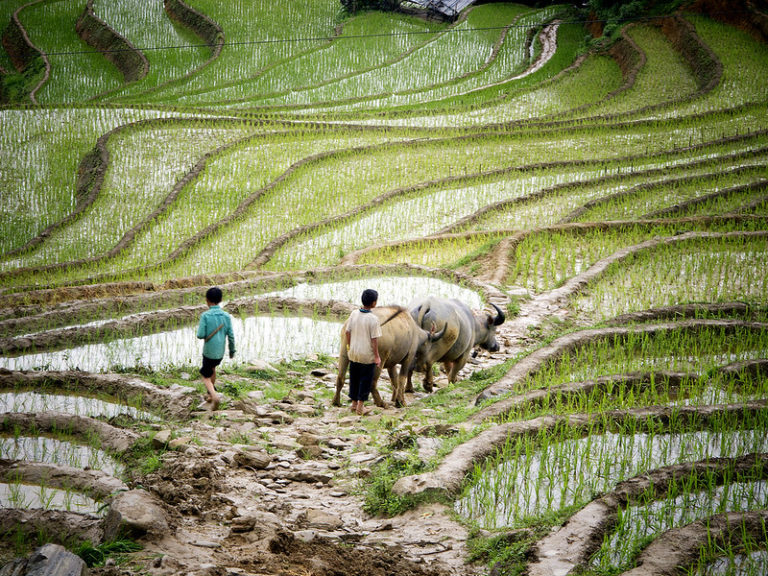Governments are spending unprecedented sums of public money in response to the COVID-19 pandemic in hopes of building a better world for our children and protecting the most vulnerable. Overnight, social and economic experiments almost too fantastic to contemplate have become real. Now, it is time to focus this global wave of creativity and financial commitment on the poorest countries, to end hunger once and for all.
How can we do this effectively, responsibly, and sustainably?
After three years of intensive research, conducted by IISD, Cornell University and the International Food Policy Research (IFPRI), and in partnership with the academic publisher Nature Research, we’ve determined that if donors double their current contributions to agriculture and food security and spend that money more wisely, we can not only end hunger but financially support struggling producers and protect the climate.
Donors currently spend USD 12 billion per year on food security and nutrition. Our calculations show that an additional USD 14 billion per year is needed to accomplish this three-part goal. But to understand how this figure was reached, it’s important to first look at how the hunger crisis and the climate crisis are connected by food and agriculture systems.
The most successful climate-resilient crops are those that are accessible through a variety of distributors, reliable, affordable, easy to grow, and produce a crop for which there is market demand.
COVID-19 brought the world’s economies to an abrupt and dramatic halt, slashing the incomes of hundreds of millions of people around the world, which immediately increased the threat of hunger for a further 95 million people. Although the climate crisis has been slower to take effect, it is no less deadly. Climate change is already exposing food systems to greater risk (think droughts and flooding, less-predictable weather patterns, the spread of new pests and diseases), which affects production and commodity markets while increasing costs.

On the flip side, food and agriculture systems have been identified as a significant source of greenhouse gas (GHG) emissions, the largest being linked to agricultural land expansion, methane emissions from livestock and rice production, and nitrous oxide from the use of synthetic fertilizers. This is why the Ceres2030 research project was determined to find solutions to hunger while maintaining GHGs levels for agriculture below commitments made in the Paris Agreement.
Related Articles: Global Stimulus Package to Avoid a COVID-19 Hunger Crisis | Solving our Food Crisis Requires a Fundamental Transformation
As we look to solutions, it’s worth noting that, to date, significant public investment has gone into developing climate-resilient crops, and there has been success: new varieties have shown their mettle against stresses such as drought, heat, flooding, salinity, novel pests, and changes to the length of growing seasons. However, there are barriers to adoption for the poorest producers.
When it comes to support, governments have never been so well equipped to direct their spending intelligently. We know more, have more experience to draw upon, and have the economic means that no previous generation in history could command.
The Ceres2030 research shows that the adoption of new practices and green technologies must be better supported, especially when it comes to proper training and extension services for poor producers. However, education levels and access to finance are also critical. The most successful climate-resilient crops are those that are accessible through a variety of distributors, reliable, affordable, easy to grow, and produce a crop for which there is market demand.

One of the organizations IISD works with, a coalition of Canadian organizations called Farmers for Climate Solutions, has produced a five-point proposal for a COVID-19 recovery plan. The plan is very much like the top findings from the Ceres2030 inquiry, which found strong evidence that: farmers’ organizations are important to farmer well-being; peer-to-peer learning is an effective but undervalued approach to supporting the adoption of new technologies; public incentives play a positive role in changing farm practices to be more climate friendly and in reducing risk created by climate change; and increased support for young farmers is sorely needed.
And when it comes to support, governments have never been so well equipped to direct their spending intelligently. We know more, have more experience to draw upon, and have the economic means that no previous generation in history could command.
That is why we are using our research findings to call on all donors to double their contributions for food security and nutrition and finally rid the world of hunger while protecting the climate. With an additional USD 14 billion per year, we can drive policies and practices that build more resilient food systems; we can strengthen investment rules that advance food security; and we can do all of this in an inclusive and environmentally sustainable way
About the author: Dr. Richard Florizone is IISD’s President and CEO. Carin Smaller is Director, Agriculture, Trade & Investment, for the Economic Law and Policy program.
EDITOR’S NOTE: The opinions expressed here by Impakter.com columnists are their own, not those of Impakter.com. — In the Featured Photo: Malnourished Child Awaits Treatment at Mogadishu Hospital. Featured Photo Credit: UN / Stuart Price.








